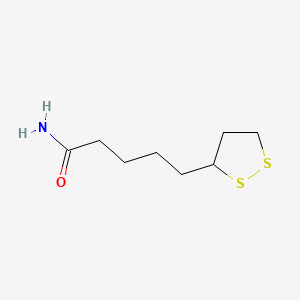| MeSH term | MeSH ID | Detail |
|---|---|---|
| Body Weight | D001835 | 333 associated lipids |
| Liver Cirrhosis, Biliary | D008105 | 12 associated lipids |
| Nerve Degeneration | D009410 | 53 associated lipids |
| Prostatic Neoplasms | D011471 | 126 associated lipids |
| Hyperglycinemia, Nonketotic | D020158 | 2 associated lipids |
lipoamide
Lipoamide is a lipid of Fatty Acyls (FA) class. Lipoamide is associated with abnormalities such as Wiskott-Aldrich Syndrome. The involved functions are known as Phosphorylation, Protonation, Mutagenesis, Site-Directed, Oxidants and Acetylation. Lipoamide often locates in Mitochondria, Mitochondrial matrix, nucleocapsid location and Chloroplasts. The associated genes with lipoamide are Mutant Proteins, Recombinant Proteins, mycothione reductase, alanylproline and Genes, Mitochondrial.
Cross Reference
Introduction
To understand associated biological information of lipoamide, we collected biological information of abnormalities, associated pathways, cellular/molecular locations, biological functions, related genes/proteins, lipids and common seen animal/experimental models with organized paragraphs from literatures.
What diseases are associated with lipoamide?
lipoamide is suspected in and other diseases in descending order of the highest number of associated sentences.
Related references are mostly published in these journals:
| Disease | Cross reference | Weighted score | Related literature |
|---|
Possible diseases from mapped MeSH terms on references
We collected disease MeSH terms mapped to the references associated with lipoamide
PubChem Associated disorders and diseases
What pathways are associated with lipoamide
There are no associated biomedical information in the current reference collection.
PubChem Biomolecular Interactions and Pathways
Link to PubChem Biomolecular Interactions and PathwaysWhat cellular locations are associated with lipoamide?
Visualization in cellular structure
Associated locations are in red color. Not associated locations are in black.
Related references are published most in these journals:
| Location | Cross reference | Weighted score | Related literatures |
|---|
What functions are associated with lipoamide?
Related references are published most in these journals:
| Function | Cross reference | Weighted score | Related literatures |
|---|
What lipids are associated with lipoamide?
There are no associated biomedical information in the current reference collection.
What genes are associated with lipoamide?
Related references are published most in these journals:
| Gene | Cross reference | Weighted score | Related literatures |
|---|
What common seen animal models are associated with lipoamide?
There are no associated biomedical information in the current reference collection.
NCBI Entrez Crosslinks
All references with lipoamide
Download all related citations| Authors | Title | Published | Journal | PubMed Link |
|---|---|---|---|---|
| Savrasova EA et al. | Use of the valine biosynthetic pathway to convert glucose into isobutanol. | 2011 | J. Ind. Microbiol. Biotechnol. | pmid:21161324 |
| Madawala SR et al. | Novel Conjugates of 1,3-Diacylglycerol and Lipoic Acid: Synthesis, DPPH Assay, and RP-LC-MS-APCI Analysis. | 2011 | J Lipids | pmid:21966595 |
| Griffin J and Engel PC | An Examination by Site-Directed Mutagenesis of Putative Key Residues in the Determination of Coenzyme Specificity in Clostridial NAD-Dependent Glutamate Dehydrogenase. | 2011 | Enzyme Res | pmid:21876794 |
| Patterson S et al. | Dihydroquinazolines as a novel class of Trypanosoma brucei trypanothione reductase inhibitors: discovery, synthesis, and characterization of their binding mode by protein crystallography. | 2011 | J. Med. Chem. | pmid:21851087 |
| Glushakova LG et al. | Increased superoxide accumulation in pyruvate dehydrogenase complex deficient fibroblasts. | 2011 | Mol. Genet. Metab. | pmid:21846590 |
| Ahidjo BA et al. | VapC toxins from Mycobacterium tuberculosis are ribonucleases that differentially inhibit growth and are neutralized by cognate VapB antitoxins. | 2011 | PLoS ONE | pmid:21738782 |
| Ah Mew N et al. | MRI features of 4 female patients with pyruvate dehydrogenase E1 alpha deficiency. | 2011 | Pediatr. Neurol. | pmid:21723463 |
| Taccola L et al. | Zinc oxide nanoparticles as selective killers of proliferating cells. | 2011 | Int J Nanomedicine | pmid:21698081 |
| Rackham O et al. | Substrate and inhibitor specificities differ between human cytosolic and mitochondrial thioredoxin reductases: Implications for development of specific inhibitors. | 2011 | Free Radic. Biol. Med. | pmid:21172426 |
| Diedrich M et al. | Brain region specific mitophagy capacity could contribute to selective neuronal vulnerability in Parkinson's disease. | 2011 | Proteome Sci | pmid:21943346 |
